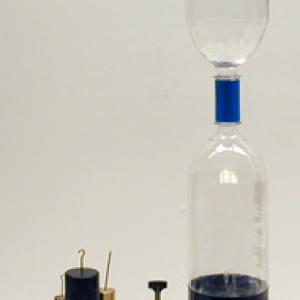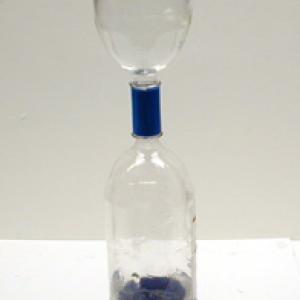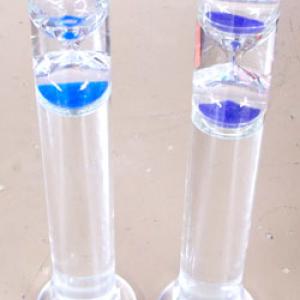College of Liberal Arts & Sciences
1G30.30 - Hourglass
Fill the soda bottles as shown and connect them together with the tornado tube apparatus. Set them on a scale and tare. Turn the bottle upside down allowing the water to move from the top bottle to the bottom. Observe the scale reading during this process which should be different from the starting reading.
- Metin Yersel, "The Flow of Sand", TPT, Vol. 38, # 5, p. 290, May 2000.
- Ian H. Redmount, "The Weight of Time", TPT, Vol. 36, # 7, p. 432, Oct. 1998.
- Little Stinkers, "More on 'Weight'", TPT, Vol. 2, # 2, Feb. 1964, p. 91.
- K. Y. Shen, Bruce L. Scott, "The Hourglass Problem", AJP, Vol. 53, # 8, Aug. 1985, p. 787.
- Walter P. Reid, "Weight of an Hourglass", AJP, Vol. 35, #4, Apr. 1967, p. 351.
- Jearl Walker, "2.16, The Weight of Time", The Flying Circus of Physics With Answers", p. 26.
- Physics Questions # 66 and # 6, Department of Physics, University of Maryland.
- Jearl Walker, "2.107, Flows in Hourglasses and Silos", The Flying Circus of Physics Ed. 2, p. 128.
- Robert Ehrlich, "Weighing an Hourglass", Why Toast Lands Jelly-Side Down, p. 38- 40.
- Neil. A. Downie, "Everlasting Hourglass", Ink Sandwiches, Electric Worms and 37 Other Experiments for Saturday Science, p. 20.
- Julius Sumner Miller, Q127 & A127, Millergrams II – Some More Enchanting Questions for Enquiring Minds, p. 18 & 81.
- "The Time Glass", Pike's Illustrated Catalogue of Scientific & Medical Instruments, 1984, p. 140.
- Queen's Catalogues Vol. I, Catalogue of Ophthalmology, p. 173.
Disclaimer: These demonstrations are provided only for illustrative use by persons affiliated with The University of Iowa and only under the direction of a trained instructor or physicist. The University of Iowa is not responsible for demonstrations performed by those using their own equipment or who choose to use this reference material for their own purpose. The demonstrations included here are within the public domain and can be found in materials contained in libraries, bookstores, and through electronic sources. Performing all or any portion of any of these demonstrations, with or without revisions not depicted here entails inherent risks. These risks include, without limitation, bodily injury (and possibly death), including risks to health that may be temporary or permanent and that may exacerbate a pre-existing medical condition; and property loss or damage. Anyone performing any part of these demonstrations, even with revisions, knowingly and voluntarily assumes all risks associated with them.



